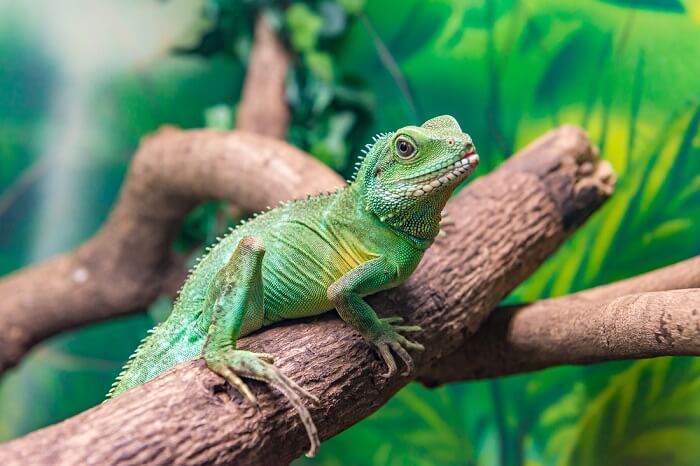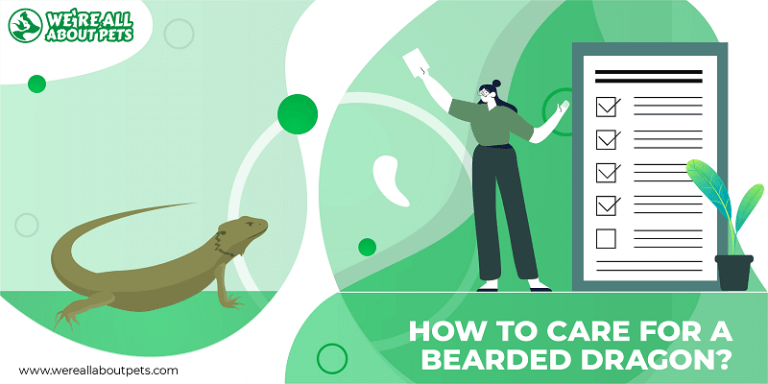How To Care For A Leopard Gecko
This page contains affiliate links. We may earn money or products from the companies mentioned in this post through our independently chosen links, which earn us a commission. Learn More
General Stats:
- Pet Type: Reptile
- Size: 7 to 10 inches
- Diet: Insectivore
- Lifespan: 6 to 10 years
When it comes to reptiles, one of the most popular pets is the leopard gecko. These spotted reptiles have big eyes and a spotted coloration, but these are just a few of the things that makes them unique.
The leopard gecko is a desert animal that requires a specific habitat to remain healthy and happy. On top of that, they need a certain type of diet. Unless you’re willing to do the research to learn everything you can about your leopard gecko’s needs and do what you can to meet them, you may want to consider a different type of pet.
If you’re willing to take on the responsibility to become a gecko owner, this leopard gecko care sheet is a great place to start. Here you’ll find everything you know as a potential leopard gecko owner.
Habitat Setup For Leopard Geckos
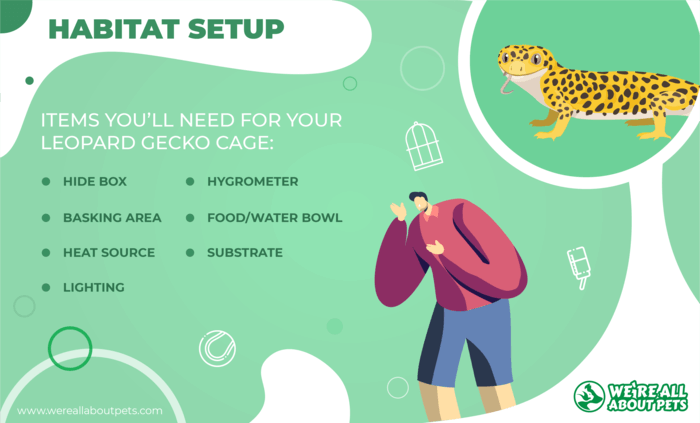
The most important thing you need to do as a leopard gecko owner is provide a suitable habitat. Leopard geckos need at least a 10 gallon tank, but 20 gallons is better. Consider a tank that provides a little extra vertical space since these geckos like to climb (as long as there are objects to climb on – they don’t have sticky toes) and make sure there is a secure top.
Here are some of the items you’ll need for your leopard gecko cage:
- Hide Box – Leopard geckos are nocturnal, so they hide during the day and need a few hiding places. Hiding spots also give your pet a place to cool down. They’ll be active in the evening and morning.
- Basking Area – Your leopard gecko enclosure should have a temperature gradient with a hot side for basking and a cool side for resting. The hot side should be around 90°F and the cool side in the upper 70s. There should be flat stones in the basking area for your gecko to stretch out.
- Heat Source – There are a few different heat source options. A heat lamp is great for basking but a heating pad under the tank is good for maintaining a minimal ambient temperature.
- Lighting – Leopard geckos do not require UVB light, but may benefit from a low-level UV light for a few hours in the evening. They do, however, need about 10 to 12 hours of daylight. Night lighting is not required.
- Hygrometer – Your leopard gecko terrarium should be kept at a humidity level between 30and 40%. A hygrometer will help you keep track – a thermostat only controls temperature. At least one of the hide boxes should have damp moss to act as a humid hide. In the wild they find burrows with higher humidity.
- Food/Water Bowl – Provide a water dish and food bowl for your leopard gecko. A shallow dish is best so your gecko can access it – remember, he doesn’t have sticky toes like other geckos.
- Substrate – You can keep it simple with paper towels or reptile carpet if you don’t want to worry about cleaning, but provide rocks or low furnishings for variety.
In addition to choosing the right equipment for your leopard gecko’s enclosure, you should also think about where to put it. Avoid direct sunlight or a location near an air conditioning vent because it could make it more challenging to maintain stable tank temperature.
Leopard Gecko Diet
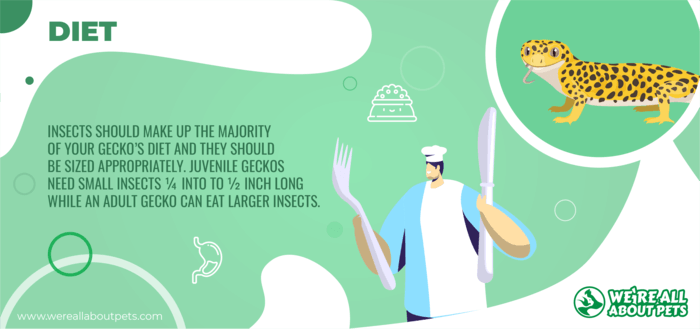
Geckos are carnivorous for the most part but leopard geckos eat more insects than anything else. Providing your gecko with a healthy and balanced diet is the key to long-term health and wellness.
Here are some quick facts about the ideal leopard gecko diet:
- Insects should make up the majority of your gecko’s diet and they should be sized appropriately. Juvenile geckos need small insects ¼ into to ½ inch long while an adult gecko can eat larger insects.
- Gut-load your feeder insects with healthy foods so the nutrition is passed on to your leopard gecko – this is easiest if you raise the insects yourself and can control their diet.
- Dust your gecko’s insects with calcium powder as needed to make sure he gets the proper nutrition. Once a week, replace the calcium using a vitamin supplement with vitamin D.
- Include a wide variety of insects in your gecko’s diet because they all have different nutritional makeup. Try to provide a balance of protein and fat – many gecko owners use a daily diet of mealworms and crickets supplemented with waxworms, roaches, and various other worms.
On top of your leopard gecko’s diet, be sure to provide unlimited access to fresh water as well. Leopard geckos will generally not eat fruits and vegetables. Meat and eggs are too high in protein for your gecko.
Leopard Gecko Veterinary Care
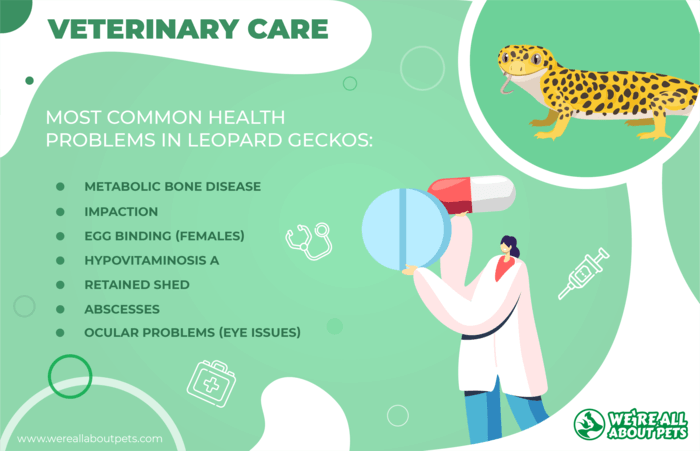
One of the most important things you can do to keep your gecko healthy over the long-term is keep an eye on his behavior. Changes in behavior are often the first sign of illness. It’s also important to familiarize yourself with common leopard gecko health problems so you can identify the symptoms.
Here are some of the most common health problems in leopard geckos:
- Metabolic bone disease (now known as Nutritional Secondary Hyperparathyroidism)
- Impaction
- Egg binding (females)
- Hypovitaminosis A
- Retained shed
- Abscesses
- Ocular problems (eye issues)
- Diarrhea
Treating health problems in leopard geckos can be tricky, but it’s still a good idea to have the number for an exotics or reptile vet who will treat your lizard. You can locate a reptile veterinarian here. Take him to the vet within a few weeks of getting him to establish a baseline for his health and follow up with annual checkups.
Leopard Gecko Fun Facts
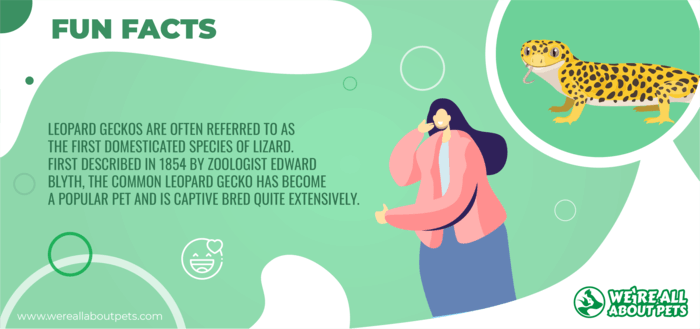
- Leopard geckos are often referred to as the first domesticated species of lizard. First described in 1854 by zoologist Edward Blyth, the common leopard gecko has become a popular pet and is captive bred quite extensively.
- Geckos, including the leopard gecko, have been known to make a “barking” noise when agitated, though they are less vocal than other gecko species.
- For many years, leopard geckos were thought to be nocturnal like other geckos, but they were increasingly observed being active during the morning and evening. While their eyes are large in proportion to their body, they are not quite as large as nocturnal species. Leopard geckos are also one of the only gecko that has “true” or movable eyelids – most are fused in a transparent cap.
- The leopard gecko has a tail that can detach if the animal is caught by a predator. They also use their tails to store fat they can draw on as an energy reserve when food is scarce.
- A leopard gecko hatchling’s gender is determined by the incubation temperature. When the eggs are incubated at 90°F, most will hatch male while an incubation temperature of 80°F will hatch more females. A temperature of 87°F will yield a nearly equal number of both.
- A gecko’s eyes are about 350 times more sensitive to light than a human and most species are nocturnal, making their vision particularly well-adapted to the seeing in the dark. Leopard geckos can see better than most other gecko species during the day.
When it comes to unique and interesting pets, the leopard gecko should definitely be on your list. These fascinating lizards are beautiful to behold and entertaining to keep, but they do come with a certain degree of responsibility (as does any pet).
Before you bring home a new pet, it’s important to make sure you know what you’re getting into. Leopard geckos require a certain habitat and a balanced diet. As long as you’re able to provide for the lizard’s needs to ensure a long and healthy life, we happily encourage you to try it.
Frequently Asked Questions
How long do leopard geckos live?
The average lifespan for a leopard gecko is about 6 to 10 years, though they have been known to live as long as 25 years in captivity.
How much do leopard geckos cost?
The average cost to keep a pet leopard gecko depends largely on the color morph you choose and the size of your enclosure. Normal leopard geckos can be found under $50, but rarer colors may cost upwards of $200. To purchase and outfit a terrarium, you’re looking at another $200 to $450.
How big do leopard geckos get?
Leopard geckos vary in size depending on the sex with males generally being larger than females. The average size is about 7 to 10 inches, though giant leopard geckos may reach 12 inches or longer.
What do leopard geckos eat?
Geckos are carnivorous but some species like the leopard gecko are primarily insectivores. These reptiles will eat a variety of insects including mealworms, roaches, waxworms, superworms, and more.
Are leopard geckos good pets?
Leopard geckos are gentle and placid by nature which is what makes them popular among children. Though they are not aggressive and can be tamed quite easily, leopard geckos still need to be handled with care. They also have certain requirements in terms of diet and habitat that make them somewhat of a challenge.
Are leopard geckos messy?
Generally speaking, leopard geckos are relatively low-maintenance pets and not particularly messy. You should spot-clean the tank daily and perform a more thorough cleaning once a week.
Where do leopard geckos come from?
The leopard gecko (Eublepharis macularius) is a ground-dwelling lizard native to the grassland and desert regions of Pakistan, Afghanistan, Iran, and northwest India.
Do leopard geckos bite?
Leopard gecko teeth are known as pleurodonts which means their teeth are constantly being replaced. Though they have many teeth, they are rather small. Leopard geckos don’t tend to bite (unless threatened) and, if they do, it doesn’t hurt much.
Do leopard geckos sleep?
While many geckos are nocturnal, leopard geckos are more crepuscular – this means they are active during dawn and dusk hours.
How long are leopard geckos pregnant for?
Like most reptiles, leopard geckos lay eggs rather than birthing live young. Female leopard geckos typically lay two eggs about 21 to 28 days after mating. In the wild, they might lay two eggs every 21 to 28 days over a 4- to 5-month breeding season. Incubation takes about 35 to 89 days to produce hatchlings, depending on the temperature. They may lay eggs even without the presence of a male.







